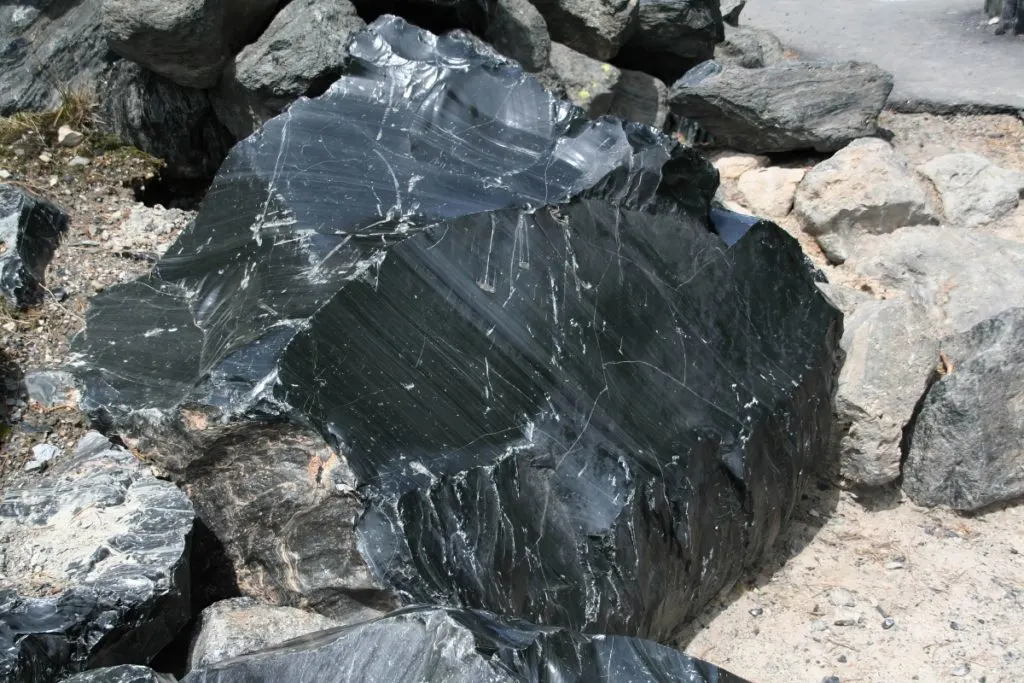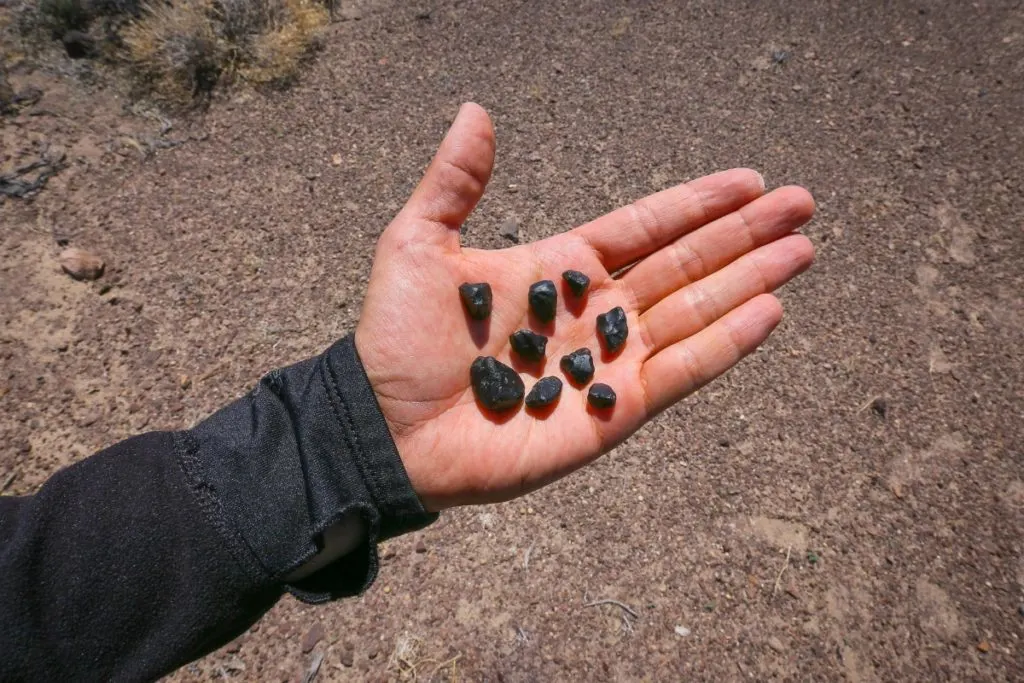As an Amazon Associate, I earn from qualifying purchases with no additional costs for you.
Obsidian is among the most prized rocks that all rockhounds want to have in their collections. This igneous rock isn’t always black as its appearance depends mostly on the impurities present within. But where to find obsidian? What sites are generally the best and where to go in the United States?
Obsidian is mostly found in areas where lava quickly cooled due to sudden contact with air or water. When lava cools along the edges of a dike, obsidian forms intrusively. Some of the most famous places to find obsidian in the world include Eolie Islands, Italy, Mount Hekla, Iceland, and Yellowstone National Park, U.S.
However, we will focus mostly on where to find obsidian in the U.S. Let’s discover together where this beautiful igneous rock is commonly found, and what are the best spots to find obsidian in the United States.

If you are interested in checking out the best books about rock and minerals identification you can find them by clicking here (Amazon link).
Where Can I Find Obsidian Near Me?
Living in the U.S. comes with some great advantages when it comes to rockhounding. This is especially true if you want to find obsidian, as the U.S. has many regions with a rich volcanic history.
The Western parts of the U.S. are the richest in obsidian as the regions contained more active or extinct volcanoes. Obsidian can be found near you if you are situated here, in volcanic vents, mines, lakes and creeks, dunes, hills, and national parks. These are the best spots to find obsidian if in the area there is any evidence of volcanism.
Volcanic Vents
Volcanic vents occur quite often, and usually without an explosive activity. When this event happens, a fissure is formed from which molten rock, gases, and hot lava erupt. It can be many miles long, but a few feet wide.
Such volcanic fields will usually birth obsidian rocks that can be collected when it is safe. Inquire if such volcanic vents were ever-present in the area where you live, and go on a little rockhounding adventure. You might be able to find obsidian with little effort.
TIP: When magma erupts from a volcano, it forms extrusive or volcanic rocks on the surface. Check out the common rocks you can find near volcanos in the article below:
Ten Most Common Types of Rocks You Can Find In Volcanoes
Mines & Mountainous Regions
Occasionally, you can find obsidian even in mines. Mines that are located near areas that were once active in volcanic activity may contain obsidian specimens that you can collect. The volcanic glass was most likely buried in time under the earth, and all that remains is for you to unearth it.
The mountainous regions of the western U.S. have a significant history of volcanism and are also worth exploring to find obsidian.
Lakes and Creeks
Since obsidian forms when lava quickly cools, bodies of water are also an excellent place to start searching for this rock. The glass stone may have formed underneath the water, or it may have been carried away during a flood from the land.
This is why you can easily find obsidian in certain lakes and creeks across the U.S. Such specimens are often tiny though, and they are more commonly known as Apache Tears.
TIP: There are plenty of natural environments in which you can rockhound. Rivers and creeks are among the best ones. Check out cool tips on finding rocks in rivers and creeks in the article below:
8 Tips On Finding Gemstones In Nature (Rivers & Creeks)
Hills, Dunes & Canyons
Obsidians can pop up in very random places, such as hills, dunes, or canyons. One of the reasons why this happens, except for past volcanic activity, is because it was carried there. Native Americans famously used obsidian to create tools, such as arrowheads.
Some of these objects can still be found even today, especially near the regions where the natives used to trade or hunt for wild animals. A stray arrow made out of obsidian is easy to find if you research the area’s history a bit.
National Parks
National Parks are famously known as the best spots where several rocks, minerals, fossils, or crystals are preserved. More often than not, it is illegal to collect items in such regions, but if you want to experience the simple joy of finding obsidian without taking it home, this is where you should go.
Many National Parks in the U.S. are situated near volcanoes or experienced some form of volcanic activity in the past. If all the other regions for finding obsidian don’t do you good, then your best bet would be to head towards a National Park.
TIP: Acquiring a piece of obsidian that needs to be cut and polished can be quite a stressful task if you have never done it before. Check out the complete guide in the article below:
How to Cut & Polish Obsidian: Follow These 7 Simple Steps
Where to Find Obsidian in the US? The Best Locations

As you can see, obsidian can be found almost anywhere in the U.S., especially in the western parts. You can find it by chance in the water, the woods, mines, hills, near volcanic vents, creeks, and National Parks, or by exploring some areas where the natives used to hunt or trade.
The best locations to find obsidian in the U.S. is the Obsidian Cliff in Yellowstone National Park, Warner Mountains, San Francisco Volcanic Field, Glass Butte Oregon, Big Southern Butte Idaho, Cochetopa Dome, Massacre Lakes, Obsidian Ridge, or the Black Rock Desert, among several others.
Obsidian Cliff, Yellowstone National Park, Wyoming
The Yellowstone National Park in Wyoming is perhaps the most iconic location to find obsidian, especially at Obsidian Cliff. Yellowstone experienced several volcanic events and the quick cooling magma resulted in many obsidian formations.
The Obsidian Cliff isn’t the only sight worth seeing, as you can also witness many obsidian specimens at the Green River area or the Jackson Hole along the Teton Pass.
Wyoming is an exceptional state for rockhounding, however, if you find yourself at the Yellowstone National Park, know that it is illegal to take anything.
TIP: For a complete rockhounding guide in Wyoming, check out this article.
Warner Mountains, Northern California
The Warner Mountains in Northern California experienced some volcanic activity in the past which led to the formation of obsidian. Here, explorers won’t find just regular black obsidian, but pink and rainbow obsidian as well, due to its contents.
In the area of the Warner Mountains, there are four mines where collecting obsidian is permitted. You also have the chance to collect obsidian at the Modoc National Forest as well, which is near.
In some regions, you will need a permit to do so. As such, the best thing is to obtain one with the local authorities.
TIP: For a complete rockhounding guide in California, check out this article.
San Francisco Volcanic Field, Arizona
Extending for over 3,000 square miles and hosting around 600 volcanic vents, the San Francisco Volcanic Field in Arizona is among the most impressive geological features of North America.
The area covered by the volcanic field extends through national parks and privately owned lands. Although enthusiasts are allowed to collect obsidian, not all the regions allow it.
This is why it should be best to ask the authorities and get permission beforehand. This way you will know where to go directly as well.
TIP: For a complete rockhounding guide in Arizona, check out this article.
Cochetopa Dome, Colorado
Another exceptionally famous spot to find obsidian in the U.S. is the Cochetopa Dome in Colorado, about 20 miles south of Gunnison. It is the only place in Colorado where you will always find obsidian.
Also known as Chochetopa Hill, it is a region where native Americans gather and search for obsidian to this day to make their arrowheads for their annual hunts. Since many private owners bought various pieces of land, various regions are off-limits to visitors.
However, the lakes and creeks are popular as during storms, many small nuggets of obsidian can be found. They are known as Apache Tears and range from ¼-2 inches in size. The traditional story behind the Apache tears is what makes them such a popular collectible rock.
It is said that the military caught the Apache tribe off-guard through a surprise attack in the area around the 1870s. Many states that the tears of the widows became pieces of obsidian after the slaughter.
The legend says that anyone who possesses an Apache Tear will never cry again as the widow’s tears will replace the stone owner’s tears.
TIP: For a complete rockhounding guide in Colorado, check out this article.
Black Rock Desert, Utah
In Millard County in western Utah, rockhounds can find obsidian at the famous Black Rock Desert. Here, you can find snowflakes, red, black, or brown obsidian. There are many areas that aren’t privately owned, so collectors can make their wishes come true.
In Piute County, which is very close, there are also several obsidian sources. However, many parts of the land are privately owned, and permission is required to collect the beautiful obsidian specimens there.
TIP: For a complete rockhounding guide in Utah, check out this article.
Obsidian Ridge, New Mexico
One of the best places to find obsidian in New Mexico is at the Obsidian Ridge. It lies along with the Jemez Volcanic field in the Jemez Mountains, about 50 miles northwest of Santa Fe.
Here, there are many places where collectors can hunt for obsidian freely, but there are also restricted areas where permits are required.
TIP: For a complete rockhounding guide in New Mexico, check out this article.
BTW: Do you want to know more about rock and mineral identification? The books listed below are the best ones you can find on the internet (Amazon links):
- Smithsonian Handbooks: Rocks & Minerals
- Gemstone & Crystal Properties (Quick Study Home)
- Ultimate Explorer Field Guide: Rocks and Minerals (National Geographic Kids)
Conclusion
The U.S. has many interesting places where you can find obsidian. If you happen to live in one of the western states, you are lucky as obsidian is the most abundant in those regions.
Wherever you decide to go and try your luck in finding obsidian, always make sure to bring the necessary tools with you, as you never know what else you might find. Also, be sure to research the laws in the area and see if you require a permit or not.
TIP: Obsidian is a valuable material with intriguing textures. It is widely used for tumbling, beads, and small sculptures. Find out more about obsidian value in the article below:
5 Crucial Factors of Obsidian Value: What’s Obsidian Worth?
